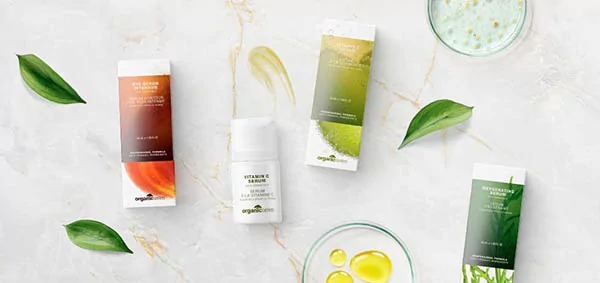DO YOU ALSO ASK YOURSELF: CREAM OR SERUM – WHAT TO CHOOSE? USE THEM TOGETHER OR INTERCHANGEABLY? AND FOR HOW LONG? IF THE ANSWER IS YES THEN YOU HAVE TO KEEP READING… These questions are frequent and reasonable, because as it turns out, we usually use these cosmetics completely without thinking about the differences between them and are guided by a hunch when deciding which cosmetic to use at a given moment. Otherwise, we are guided by habits and once again reach for e.g. the same cream. Maybe it’s worth exploring the topic to see when and why you should reach for the serum.
WHAT IS THE CHARACTERISTICS OF A SERUM?
Serum is a type of concentrate containing a high concentration of active ingredients. It works more intensively than cream, but at the same time it has a lighter texture. This cosmetic should be reached when the cosmetic problem is intensified, e.g. if you are struggling with dry skin, damaged hair, nails or changes caused by aging. Due to the large amount of concentrated active ingredients, the serum will act like a medicine. As already mentioned, despite the higher concentration of active ingredients, the serum usually has a lighter texture than the cream. It usually has the form of a gel or watery mask. The choice of this consistency is not accidental. This formula allows the active ingredients to reach deep layers of the skin. At the same time, it does not leave a greasy film on the skin or hair, and does not clog pores. The concentration of the desired active ingredients and action in the deep layers of the skin translate into a more effective cosmetic effect. Once we deal with the problem and notice a visible improvement, we can reach for a slightly milder cosmetic – cream, lotion, etc.
HOW AND WHEN TO USE SERUM?
As a concentrate serum quickly brings visible, good results. However, it shouldn’t be used for more than a few weeks. After this time, you should reach for a cream, conditioner or shampoo with similar properties, but a lower concentration of ingredients, so the skin, hair or nails not to get used to continuous action with the concentrated strength of the components, but to stimulate their natural regenerative processes.
The serum should be used as an addition to the morning and evening care. It should be the first cosmetic we apply immediately after cleansing the skin. If you intend to use the cream additionally, you should leave at least a 10-minute break between applying those cosmetics.
After a few minutes you can or actually you should , apply the cream because:
the cream stays better on the face, so it protects the serum ingredients from running down or evaporating,
the skin with cream better accepts foundation and subsequent layers of makeup,
the use of a good SPF cream gives us sun protection.
The serum should rather not replace a standard cream or other cosmetic, but should be a supplement when our skin, hair or nails need more help. We reach for this product when our skin or hair is damaged and requires a thorough, effective reconstruction. Many people decide to take a serum treatment as a post-regenerative regeneration, a panacea for the first or progressive signs of aging, or simply to improve the poor condition of hair, skin or nails. However, it is worth emphasizing once again that the serum should complement your skin care routine.
A concentrated cosmetic is best used 2-3 times a year, limited to a few weeks of treatment.
First of all, we reach for the serum after winter, when the skin is dry, tired and gray to properly strengthen, nourish and regenerate it. Most often we use this cosmetic for the second time after the summer, rebuilding the condition of dermis damaged and weakened by such factors as sun, wind or sea water. A third time is already an individual matter – we simply support ourselves with the serum when we feel that our skin, hair or nails clearly need it.
SERUM TYPES
You will find many cosmetics of this type on the market – brightening, moisturizing, regenerating, anti-wrinkle etc. etc. It is important to choose a product adapted to the type of our skin, hair, nails and their current needs. The most popular types are:
face serum – depending on the composition and formula, it can perform various tasks: deeply moisturize, reduce wrinkles, gently tighten and smooth the skin, lighten discolorations and even out skin tone, etc.,
body serum – fights cellulite, stretch marks, firms, smoothes and tightens the skin of the abdomen, thighs, buttocks, etc.
hair serum – is primarily intended to rebuild the condition of the hair; usually fights with the problem of weak, dry, brittle hair and split ends – the serum will help rebuild the hair structure, strengthen it, make it healthier and shiny.
nail serum – it is a help for splitting and brittle nails; the serum reaches deep into the nail plate, providing it with essential vitamins and other nutrients.
PRECAUTIONS WHEN USING SERUM
Despite the many advantages of this cosmetic, there are several cases when you shouldn’t reach for the serum.
- serum is not recommended when the skin is recovering, e.g. after a rather intensive cosmetic treatment, because the high concentration of active ingredients may additionally irritate it,
- one should always carefully look at the composition of the cosmetic, e.g. a serum containing vitamin A should not be used in the summer, because retinol “does not harmonize well” with the sun.
AND WHAT IS ALSO IMPORTANT I.E. WHAT SERUM TO CHOOSE?
As we have already mentioned, serum is a kind of concentrate, therefore the more active ingredients, the better the product and this is the only case when a long list of ingredients is better than short – it is important to read what these ingredients are. If we have a dilemma which product to choose, all we have to do is compare the descriptions and choose the richer one.
We can also have a look at the share of water in the serum components. Not everyone knows that to a large extent this base component can be replaced by hydrolates that perform active functions. Unfortunately, this affects the price of the product, but it is beneficial to the skin and extends the effect of the cosmetic.
delta
All Author Posts

